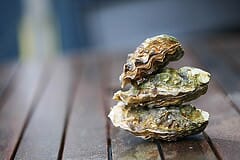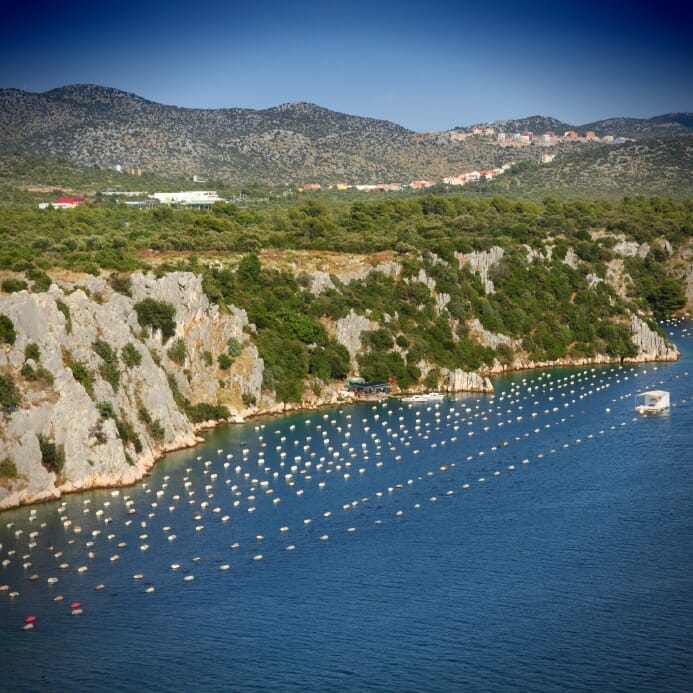With national, regional, and local governments, as well as industry and the public failing to take meaningful steps to reduce emissions, levels are only set to increase.
Climate change is perhaps the most well-known consequence of our continued emissions, but of increasing concern is climate change’s “evil twin” – ocean acidification.
Around 30% of atmospheric CO2 is soaked up by the ocean where it forms carbonic acid (H2CO3), which in turn breaks down into bicarbonate (HCO¬3) and hydrogen (H+) ions.
Bicarbonate ions can break down further into carbonate ions (CO23) and a hydrogen ion. It is the increase in the concentration of hydrogen ions that decreases ocean pH. This chemical reaction is entirely natural, but the speed and magnitude of current and predicted change is far greater than known historical rates.
Since the industrial revolution the pH of ocean surface waters has declined by 0.1 pH units. This deceptively small change represents a 26% - 30% increase in ocean acidity.
Projected atmospheric CO2 levels suggest that by the end of the century, global ocean pH will drop by 0.3 – 0.4 units - an increase in acidity by 100% – 150%.
Numerous studies have indicated acidification and in some cases more specifically, saturation state (the amount of carbonate dissolved in seawater relative to the maximum it can hold) will have impacts on marine life, including species used for mariculture.
Arguably most at risk are the shellfish and crustaceans whose calcium-carbonate shells can effectively dissolve under acidification.

Ex-situ experiments performed by Northeastern University’s Justin Ries, which simulated atmospheric CO2 levels predicted by 2100, demonstrated that adults from a number of species including clams, scallops, and mussels, will suffer shell deterioration.
Not all species are created equal, however. Justin also found that some species like American lobster built thicker shells as CO2 levels increased, but at an increased energy expenditure cost. Exactly why some species respond by building thicker shells whilst others don’t is an area of ongoing research.
As pH levels drop, options for rebuilding may become more limited. Acidification reduces the availability of carbonate ions (required for building carbonate shells) in seawater. This is particularly problematic for the larval stages of many species, such as oysters and mussels which, in order to begin feeding fast enough to be able to survive, need to build their carbonate shells within 48 hours.
When carbonate is low, the larvae expend more energy building shells. Exhaustion can set in resulting in 'lazy larvae syndrome', so called by hatcheries because the larvae simply stop swimming and sink.
Research from Oregon State University suggests that larval stages of such species are particularly sensitive to saturation state, suffering high levels of mortality if saturation state dips too low. This is appears to be the primary cause of Oregon-based Whiskey Creek Shellfish Hatchery’s loss of some 80% of its annual larval production in 2007 and 2008, nearly resulting in the Hatchery’s closure, the loss of some 3,200 jobs.
Acidification impacts more than just carbonate shells. The next generation of mussel mariculturalists may, for example, find increasing levels of dislodgement from ropes.

Work by Michael O’Donnell (University of Washington) suggests that the byssal threads that extend from the mussel’s foot and cling to the surface can weaken and become less extendable. Under pH levels predicted by 2100, byssal threads could lose up to 40% of their tenacity (strength).
In areas that also undergo high temperature increases, this loss of tenacity could increase up to 60%. Work by other researchers suggests that the mussel group may also suffer decreases in growth and development under increasing ocean acidification.
Much more work on the impacts of acidification to shell-building species is required to enable us to fully understand what the implications to industry may be.
Lagging behind impacts to shellfish is our understanding of impacts to finfish species. There is some evidence to suggest that larval and even adult stages of some wild fish populations may suffer behavioural changes or sensory disruption, negatively impacting settlement cues, predator avoidance, or hunting.
What such changes could mean for finfish raised in mariculture – if they occur at all – is unknown.
Like shellfish, the larval stages of finfish are most vulnerable to changes in oceanic condition. As such, mariculturalists who raise young finfish in closed systems may avoid the most damaging direct impacts of acidification.
However, finfish mariculturalists may still be impacted indirectly by acidification, such as through food-web alterations that impact wild stocks used in fish food, or via harmful algal blooms which are thought to increase with both acidifying and warming waters.



